Design and Preparation of Chitosan-Crosslinked Bismuth Ferrite/Biochar Coupled Magnetic Material for Methylene Blue Removal
Abstract
1. Introduction
2. Materials and Methods
2.1. Material Preparation
2.1.1. Preparation of Biochar
2.1.2. Preparation of BiFeO3
2.1.3. Synthesis of BiFeO3/Biochar Coupled Magnetic Material
2.2. Characterization Methods
2.3. Adsorption Experiments
2.3.1. Effect of pH on Adsorption
2.3.2. Effect of Adsorbent Dose on Adsorption
2.3.3. Effect of Initial Methylene Blue Concentration C0 and Reaction Temperature on Adsorption
2.3.4. Effect of Reaction Time on Adsorption
2.3.5. Regeneration and Reuse Experiments
3. Results
3.1. Characterization
3.2. Effect of pH
3.3. Effect of Adsorbent Dose
3.4. Effect of Initial Methylene Blue Concentration C0 and Reaction Temperature
3.5. Effect of Reaction Time
3.6. Adsorption Isotherms
3.7. Adsorption Kinetics
3.8. Reuse of BiFeO3/Biochar Coupled Magnetic Material
4. Conclusions
Author Contributions
Funding
Conflicts of Interest
References
- Gupta, K.; Khatri, O.P. Fast and efficient adsorptive removal of organic dyes and active pharmaceutical ingredient by microporous carbon: Effect of molecular size and charge. Chem. Eng. J. 2019, 378, 12. [Google Scholar] [CrossRef]
- Liu, Z.W.; Cao, C.X.; Han, B.H. A cationic porous organic polymer for high-capacity, fast, and selective capture of anionic pollutants. J. Hazard. Mater. 2019, 367, 348–355. [Google Scholar] [CrossRef] [PubMed]
- Jayapal, M.; Jagadeesan, H.; Shanmugam, M.; Danisha, J.P.; Murugesan, S. Sequential anaerobic-aerobic treatment using plant microbe integrated system for degradation of azo dyes and their aromatic amines by-products. J. Hazard. Mater. 2018, 354, 231–243. [Google Scholar] [CrossRef] [PubMed]
- Liu, Y.; Jin, W.; Zhao, Y.; Zhang, G.; Zhang, W. Enhanced catalytic degradation of methylene blue by α-Fe2O3/graphene oxide via heterogeneous photo-Fenton reactions. Appl. Catal. B Environ. 2017, 206, 642–652. [Google Scholar] [CrossRef]
- Huo, H.W.; Hu, X.J.; Wang, H.; Li, J.; Xie, G.Y.; Tan, X.F.; Jin, Q.; Zhou, D.X.; Li, C.; Qiu, G.Q.; et al. Synergy of Photocatalysis and Adsorption for Simultaneous Removal of Hexavalent Chromium and Methylene Blue by g-C3N4/BiFeO3/Carbon Nanotubes Ternary Composites. Int. J. Environ. Res. Public Health 2019, 16, 18. [Google Scholar] [CrossRef]
- Sheng, J.; Xie, Y.; Zhou, Y. Adsorption of methylene blue from aqueous solution on pyrophyllite. Appl. Clay Sci. 2009, 46, 422–424. [Google Scholar] [CrossRef]
- Que, W.; Jiang, L.H.; Wang, C.; Liu, Y.G.; Zeng, Z.W.; Wang, X.H.; Ning, Q.M.; Liu, S.H.; Zhang, P.; Liu, S.B. Influence of sodium dodecyl sulfate coating on adsorption of methylene blue by biochar from aqueous solution. J. Environ. Sci. 2018, 70, 166–174. [Google Scholar] [CrossRef]
- Van Der Zee, F.P.; Lettinga, G.; Field, J.A. Azo dye decolourisation by anaerobic granular sludge. Chemosphere 2001, 44, 1169–1176. [Google Scholar] [CrossRef]
- Zeng, G.M.; Cheng, M.; Huang, D.L.; Lai, C.; Xu, P.A.; Wei, Z.; Li, N.J.; Zhang, C.; He, X.X.; He, Y. Study of the degradation of methylene blue by semi-solid-state fermentation of agricultural residues with Phanerochaete chrysosporium and reutilization of fermented residues. Waste Manag. 2015, 38, 424–430. [Google Scholar] [CrossRef]
- Wu, Z.B.; Zhong, H.; Yuan, X.Z.; Wang, H.; Wang, L.L.; Chen, X.H.; Zeng, G.M.; Wu, Y. Reply for comment on “Adsorptive removal of methylene blue by rhamnolipid-functionalized graphene oxide from wastewater”. Water Res. 2017, 108, 464–465. [Google Scholar] [CrossRef]
- He, K.; Chen, G.Q.; Zeng, G.M.; Chen, A.W.; Huang, Z.Z.; Shi, J.B.; Peng, M.; Huang, T.T.; Hu, L. Enhanced removal performance for methylene blue by kaolin with graphene oxide modification. J. Taiwan Inst. Chem. Eng. 2018, 89, 77–85. [Google Scholar] [CrossRef]
- He, K.; Zeng, G.M.; Chen, A.W.; Huang, Z.Z.; Peng, M.; Huang, T.T.; Chen, G.Q. Graphene hybridized polydopamine-kaolin composite as effective adsorbent for methylene blue removal. Compos. Part B Eng. 2019, 161, 141–149. [Google Scholar] [CrossRef]
- Tan, X.F.; Liu, S.B.; Liu, Y.G.; Gu, Y.L.; Zeng, G.M.; Hua, X.J.; Wang, X.; Liu, S.H.; Jiang, L.H. Biochar as potential sustainable precursors for activated carbon production: Multiple applications in environmental protection and energy storage. Bioresour. Technol. 2017, 227, 359–372. [Google Scholar] [CrossRef]
- Siyal, A.A.; Shamsuddin, M.R.; Khan, M.I.; Rabat, N.E.; Zulfiqar, M.; Man, Z.; Siame, J.; Azizli, K.A. A review on geopolymers as emerging materials for the adsorption of heavy metals and dyes. J. Environ. Manag. 2018, 224, 327–339. [Google Scholar] [CrossRef] [PubMed]
- Tan, X.; Liu, Y.; Gu, Y.; Xu, Y.; Zeng, G.; Hu, X.; Liu, S.; Wang, X.; Liu, S.; Li, J. Biochar-based nano-composites for the decontamination of wastewater: A review. Bioresour. Technol. 2016, 212, 318–333. [Google Scholar] [CrossRef]
- Ding, Y.; Liu, Y.G.; Liu, S.B.; Li, Z.W.; Tan, X.F.; Huang, X.X.; Zeng, G.M.; Zhou, L.; Zheng, B.H. Biochar to improve soil fertility. A review. Agron. Sustain. Dev. 2016, 36, 18. [Google Scholar] [CrossRef]
- Li, L.Q.; Song, J.F.; Yao, X.L.; Huang, G.J.; Liu, Z.; Tang, L. Adsorption of volatile organic compounds on three activated carbon samples: Effect of pore structure. J. Cent. South Univ. 2012, 19, 3530–3539. [Google Scholar] [CrossRef]
- Ahmad, M.; Rajapaksha, A.U.; Lim, J.E.; Zhang, M.; Bolan, N.; Mohan, D.; Vithanage, M.; Lee, S.S.; Ok, Y.S. Biochar as a sorbent for contaminant management in soil and water: A review. Chemosphere 2014, 99, 19–33. [Google Scholar] [CrossRef]
- Inyang, M.I.; Gao, B.; Yao, Y.; Xue, Y.; Zimmerman, A.; Mosa, A.; Pullammanappallil, P.; Ok, Y.S.; Cao, X. A review of biochar as a low-cost adsorbent for aqueous heavy metal removal. Crit. Rev. Environ. Sci. Technol. 2016, 46, 406–433. [Google Scholar] [CrossRef]
- Li, H.; Jiang, D.N.; Huang, Z.Z.; He, K.; Zeng, G.M.; Chen, A.W.; Yuan, L.; Peng, M.; Huang, T.T.; Chen, G.Q. Preparation of silver-nanoparticle-loaded magnetic biochar/poly (dopamine) composite as catalyst for reduction of organic dyes. J. Colloid Interface Sci. 2019, 555, 460–469. [Google Scholar] [CrossRef]
- Li, M.X.; Liu, H.B.; Chen, T.H.; Dong, C.; Sun, Y.B. Synthesis of magnetic biochar composites for enhanced uranium (VI) adsorption. Sci. Total Environ. 2019, 651, 1020–1028. [Google Scholar] [CrossRef] [PubMed]
- Gareeva, Z.V.; Dieguez, O.; Iniguez, J.; Zvezdin, A.K. Interplay between elasticity, ferroelectricity and magnetism at the domain walls of bismuth ferrite. Phys. Status Solidi Rapid Res. Lett. 2016, 10, 209–217. [Google Scholar] [CrossRef]
- Fiebig, M.; Lottermoser, T.; Meier, D.; Trassin, M. The evolution of multiferroics. Nat. Rev. Mater. 2016, 1, 16046. [Google Scholar] [CrossRef]
- Zhu, Z.; Zhang, Z.H.; Wang, D.; Deng, X.Q.; Fan, Z.Q.; Tang, G.P. Magnetic structure and magnetic transport characteristics of nanostructures based on armchair-edged graphene nanoribbons. J. Mater. Chem. C 2015, 3, 9657–9663. [Google Scholar] [CrossRef]
- Zhang, X.; Tan, X.; Xu, Y.; Wang, W.; Ma, L.; Qi, W. Preparation of core-shell structure magnetic carbon-based solid acid and its catalytic performance on hemicellulose in corncobs. BioResources 2016, 11, 10014–10029. [Google Scholar] [CrossRef][Green Version]
- Song, S.H.; Zhu, Q.S.; Weng, L.Q.; Mudinepalli, V.R. A comparative study of dielectric, ferroelectric and magnetic properties of BiFeO3 multiferroic ceramics synthesized by conventional and spark plasma sintering techniques. J. Eur. Ceram. Soc. 2015, 35, 131–138. [Google Scholar] [CrossRef]
- Hu, X.J.; Wang, W.X.; Xie, G.Y.; Wang, H.; Tan, X.F.; Jin, Q.; Zhou, D.X.; Zhao, Y.L. Ternary assembly of g-C3N4/graphene oxide sheets/BiFeO3 heterojunction with enhanced photoreduction of Cr(VI) under visible-light irradiation. Chemosphere 2019, 216, 733–741. [Google Scholar] [CrossRef]
- Campanini, M.; Erni, R.; Yang, C.H.; Ramesh, R.; Rossell, M.D. Periodic Giant Polarization Gradients in Doped BiFeO3 Thin Films. Nano Lett. 2018, 18, 717–724. [Google Scholar] [CrossRef]
- Lai, C.; Huang, F.L.; Zeng, G.M.; Huang, D.L.; Qin, L.; Cheng, M.; Zhang, C.; Li, B.S.; Yi, H.; Liu, S.Y.; et al. Fabrication of novel magnetic MnFe2O4/bio-char composite and heterogeneous photo-Fenton degradation of tetracycline in near neutral pH. Chemosphere 2019, 224, 910–921. [Google Scholar] [CrossRef]
- Zhang, P.; Huang, W.; Xu, H.; Chang, S.; Cao, C.; Kong, M.; He, Y. Magnetic cylindrical ordered mesoporous nanocarriers for targeted drug delivery. Microporous Mesoporous Mater. 2014, 188, 86–92. [Google Scholar] [CrossRef]
- Deng, J.Q.; Liu, Y.Q.; Liu, S.B.; Zeng, G.M.; Tan, X.F.; Huang, B.Y.; Tang, X.J.; Wang, S.F.; Hua, Q.; Yan, Z.L. Competitive adsorption of Pb(II), Cd(II) and Cu(II) onto chitosan-pyromellitic dianhydride modified biochar. J. Colloid Interface Sci. 2017, 506, 355–364. [Google Scholar] [CrossRef] [PubMed]
- Wen, J.; Zeng, G.M. Chemical and biological assessment of Cd-polluted sediment for land use: The effect of stabilization using chitosan-coated zeolite. J. Environ. Manag. 2018, 212, 46–53. [Google Scholar] [CrossRef] [PubMed]
- Zhang, L.; Zeng, Y.; Cheng, Z. Removal of heavy metal ions using chitosan and modified chitosan: A review. J. Mol. Liq. 2016, 214, 175–191. [Google Scholar] [CrossRef]
- Luo, W.; Zhu, L.; Wang, N.; Tang, H.; Cao, M.; She, Y. Efficient Removal of Organic Pollutants with Magnetic Nanoscaled BiFeO3 as a Reusable Heterogeneous Fenton-Like Catalyst. Environ. Sci. Technol. 2010, 44, 1786–1791. [Google Scholar] [CrossRef]
- Zhang, P.; Tan, X.; Liu, S.; Liu, Y.; Zeng, G.; Ye, S.; Yin, Z.; Hu, X.; Liu, N. Catalytic degradation of estrogen by persulfate activated with iron-doped graphitic biochar: Process variables effects and matrix effects. Chem. Eng. J. 2019, 378, 122141. [Google Scholar] [CrossRef]
- Liu, S.J.; Liu, Y.G.; Tan, X.F.; Liu, S.B.; Li, M.F.; Liu, N.; Yin, Z.H.; Tian, S.R.; Zhou, Y.H. Facile synthesis of MnOx-loaded biochar for the removal of doxycycline hydrochloride: Effects of ambient conditions and co-existing heavy metals. J. Chem. Technol. Biotechnol. 2019, 94, 2187–2197. [Google Scholar]
- Kaminska, I.; Barras, A.; Coffinier, Y.; Lisowski, W.; Roy, S.; Niedziolka-Jonsson, J.; Woisel, P.; Lyskawa, J.; Opallo, M.; Siriwardena, A.; et al. Preparation of a Responsive Carbohydrate-Coated Biointerface Based on Graphene/Azido-Terminated Tetrathiafulvalene Nanohybrid Material. ACS Appl. Mater. Interfaces 2012, 4, 5386–5393. [Google Scholar] [CrossRef]
- Zhang, P.; Liu, S.; Tan, X.; Liu, Y.; Zeng, G.; Yin, Z.; Ye, S.; Zeng, Z. Microwave-assisted chemical modification method for surface regulation of biochar and its application for estrogen removal. Process Saf. Environ. Prot. 2019, 128, 329–341. [Google Scholar] [CrossRef]
- Lachheb, H.; Puzenat, E.; Houas, A.; Ksibi, M.; Elaloui, E.; Guillard, C.; Herrmann, J.-M. Photocatalytic degradation of various types of dyes (Alizarin S, Crocein Orange G, Methyl Red, Congo Red, Methylene Blue) in water by UV-irradiated titania. Appl. Catal. B Environ. 2002, 39, 75–90. [Google Scholar] [CrossRef]
- Min, H.; Girard Lauriault, P.L.; Gross, T.; Lippitz, A.; Dietrich, P.; Unger, W.E.S. Ambient-ageing processes in amine self-assembled monolayers on microarray slides as studied by ToF-SIMS with principal component analysis, XPS, and NEXAFS spectroscopy. Anal. Bioanal. Chem. 2012, 403, 613–623. [Google Scholar] [CrossRef]
- Travlou, N.A.; Kyzas, G.Z.; Lazaridis, N.K.; Deliyanni, E.A. Functionalization of graphite oxide with magnetic chitosan for the preparation of a nanocomposite dye adsorbent. Langmuir 2013, 29, 1657–1668. [Google Scholar] [CrossRef] [PubMed]
- Huang, L.J.; Shuai, Q.; Hu, S.H. Tannin-based magnetic porous organic polymers as robust scavengers for methylene blue and lead ions. J. Clean. Prod. 2019, 215, 280–289. [Google Scholar] [CrossRef]
- Chen, Y.X.; Liang, Y.; Li, T.T.; Lin, C.Q.; Lin, L.; Zhao, M.J.; Wan, Y.; Chen, H.; Zeng, J.; Zhang, Y.S. Hydrothermal fabrication of sandwich-structured Silver sulfide/ferroferric oxide/silver metavanadate graphene microtube using capillary effect for enhancing photocatalytic degradation and disinfection. J. Colloid Interface Sci. 2019, 555, 759–769. [Google Scholar] [CrossRef] [PubMed]
- Shete, P.B.; Patil, R.M.; Tiwale, B.M.; Pawar, S.H. Water dispersible oleic acid-coated Fe3O4 nanoparticles for biomedical applications. J. Magn. Magn. Mater. 2015, 377, 406–410. [Google Scholar] [CrossRef]
- Tan, X.; Liu, Y.; Zeng, G.; Wang, X.; Hu, X.; Gu, Y.; Yang, Z. Application of biochar for the removal of pollutants from aqueous solutions. Chemosphere 2015, 125, 70–85. [Google Scholar] [CrossRef]
- Rana, C.; De Malsche, W.; De Wit, A. Decreased peak tailing during transport of solutes in porous media with alternate adsorption properties. Chem. Eng. Sci. 2019, 203, 415–424. [Google Scholar] [CrossRef]
- Piri, M.; Sepehr, E.; Rengel, Z. Citric acid decreased and humic acid increased Zn sorption in soils. Geoderma 2019, 341, 39–45. [Google Scholar] [CrossRef]
- Swenson, H.; Stadie, N.P. Langmuir’s Theory of Adsorption: A Centennial Review. Langmuir 2019, 35, 5409–5426. [Google Scholar] [CrossRef]
- Sun, Z.; Liu, Y.; Huang, Y.; Tan, X.; Zeng, G.; Hu, X.; Yang, Z. Fast adsorption of Cd2+ and Pb2+ by EGTA dianhydride (EGTAD) modified ramie fiber. J. Colloid Interface Sci. 2014, 434, 152–158. [Google Scholar] [CrossRef]
- Yang, L.; Zhong, W.; Li, S.; Wei, Z. Fast removal of methylene blue from aqueous solution by adsorption onto poorly crystalline hydroxyapatite nanoparticles. Dig. J. Nanomater. Bios. 2015, 19, 1343–1363. [Google Scholar]
- Li, Y.; Zhang, Y.; Zhang, Y.; Wang, G.; Li, S.; Han, R.; Wei, W. Reed biochar supported hydroxyapatite nanocomposite: Characterization and reactivity for methylene blue removal from aqueous media. J. Mol. Liq. 2018, 263, 53–63. [Google Scholar] [CrossRef]
- Ghosh, D.; Bhattacharyya, K.G. Adsorption of methylene blue on kaolinite. Appl. Clay Sci. 2002, 20, 295–300. [Google Scholar] [CrossRef]
- Gong, J.L.; Wang, B.; Zeng, G.M.; Yang, C.P.; Niu, C.G.; Niu, Q.Y.; Zhou, W.J.; Liang, Y. Removal of cationic dyes from aqueous solution using magnetic multi-wall carbon nanotube nanocomposite as adsorbent. J. Hazard. Mater. 2009, 164, 1517–1522. [Google Scholar] [CrossRef]
- Aslam Malana, M.; Parveen, S.; Beenish Qureshi, R. Adsorptive removal of organic dyes from aqueous solutions using acrylic acid–acrylonitrile–N-isopropylacrylamide polymeric gels as adsorbents: Linear and non-linear isotherms. Desalin. Water Treat. 2016, 57, 22543–22550. [Google Scholar] [CrossRef]
- Zhao, D.; Zhao, L.; Zhu, C.S.; Huang, W.Q.; Hu, J.L. Water-insoluble β-cyclodextrin polymer crosslinked by citric acid: Synthesis and adsorption properties toward phenol and methylene blue. J. Incl. Phenom. Macrocycl. Chem. 2009, 63, 195–201. [Google Scholar] [CrossRef]
- Hu, X.; Wang, J.; Liu, Y.; Li, X.; Zeng, G.; Bao, Z.; Zeng, X.; Chen, A.; Long, F. Adsorption of chromium (VI) by ethylenediamine-modified cross-linked magnetic chitosan resin: Isotherms, kinetics and thermodynamics. J. Hazard. Mater. 2011, 185, 306–314. [Google Scholar] [CrossRef] [PubMed]
- Zaid, R.M.; Mishra, P.; Ab Wahid, Z.; Sakinah, A.M.M. Hylocereus polyrhizus peel’s high-methoxyl pectin: A potential source of hypolipidemic agent. Int. J. Biol. Macromol. 2019, 134, 361–367. [Google Scholar] [CrossRef]


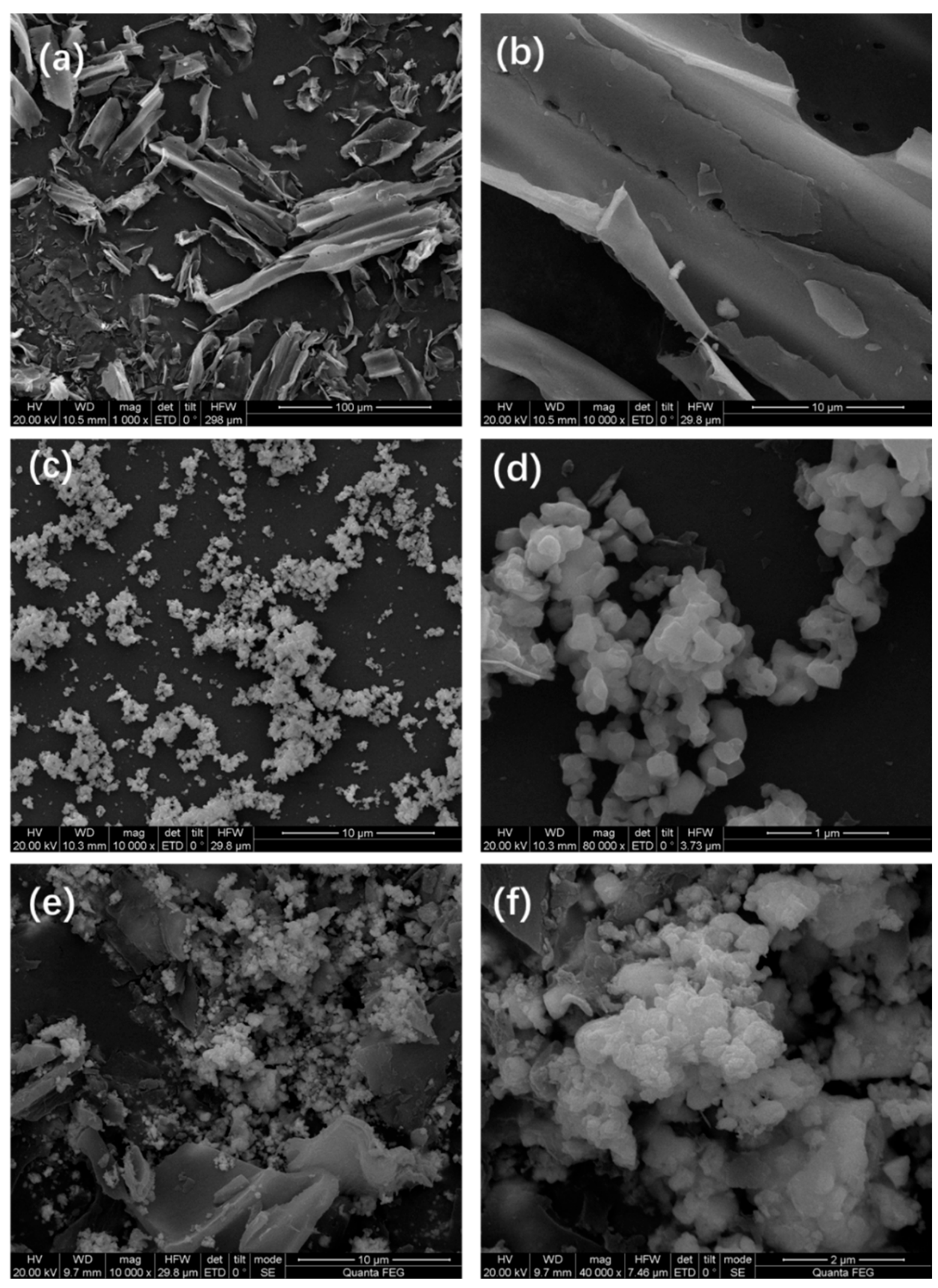

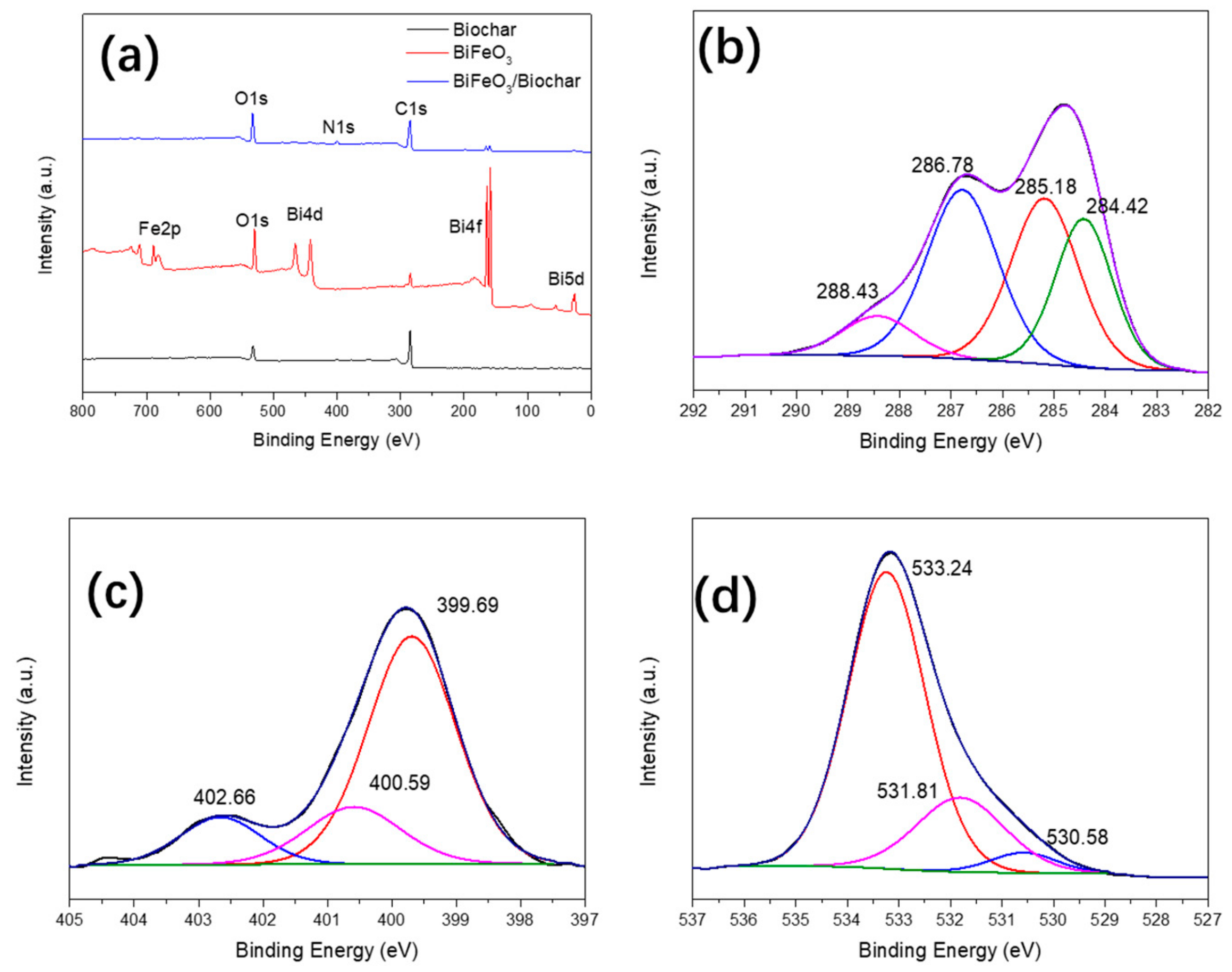
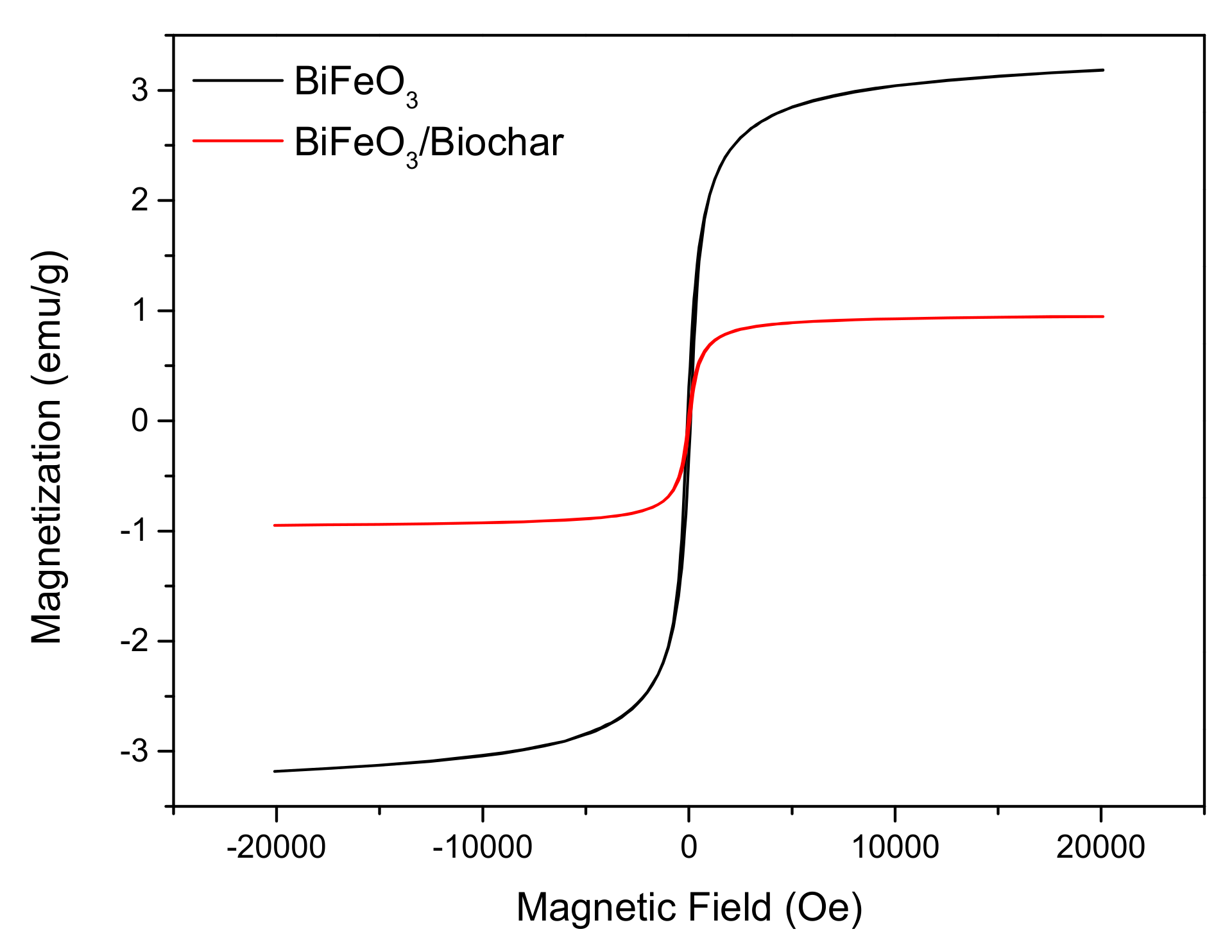
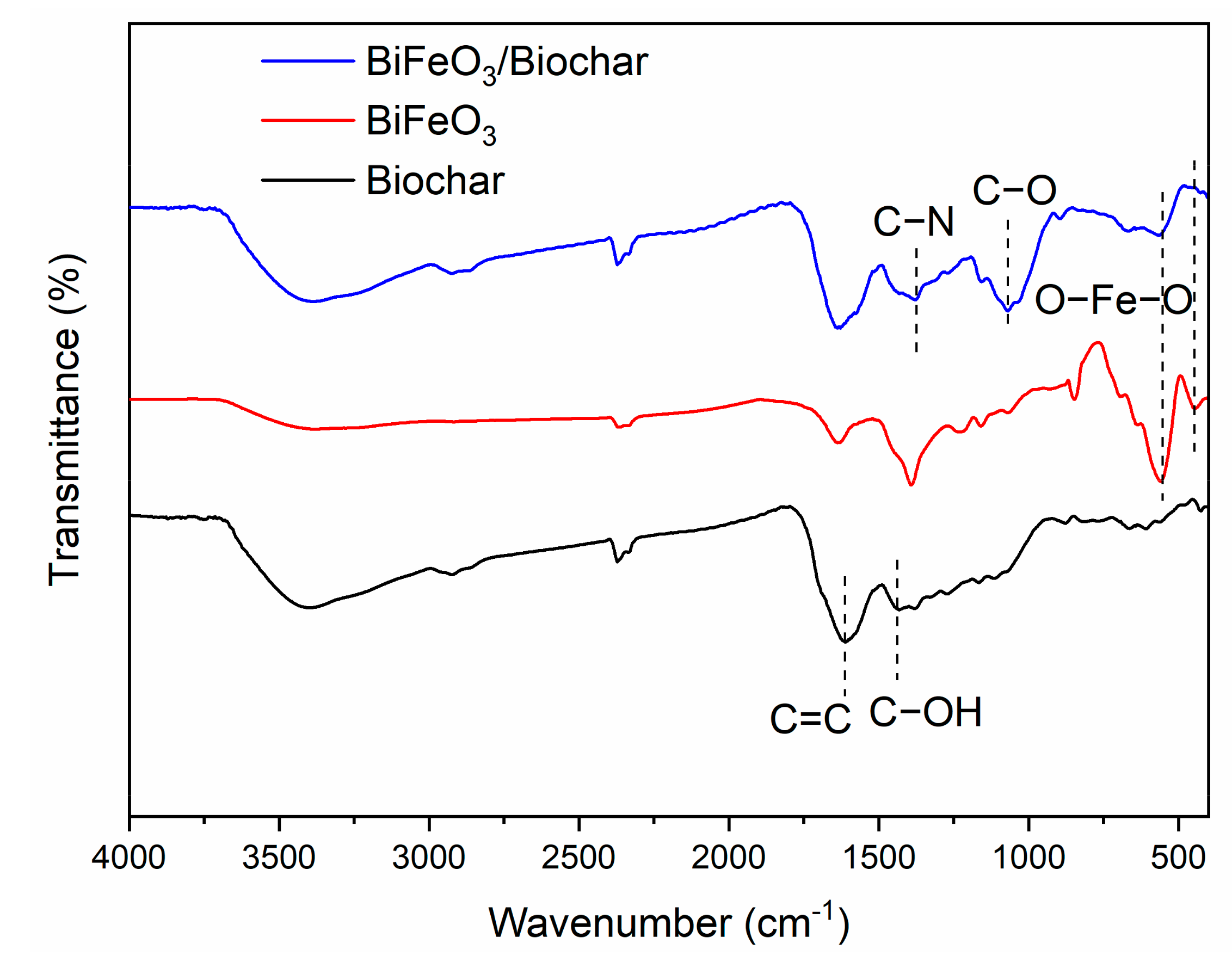
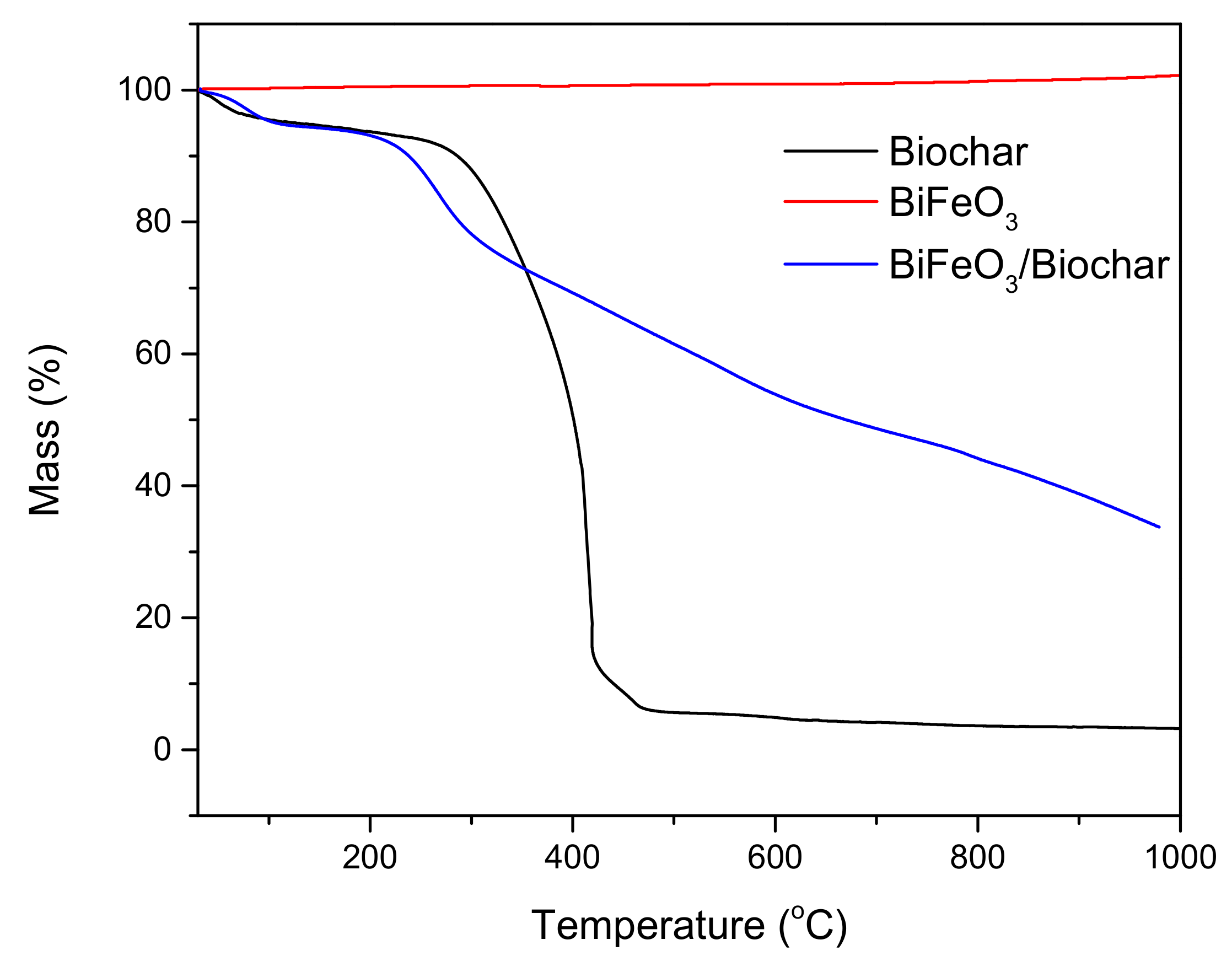

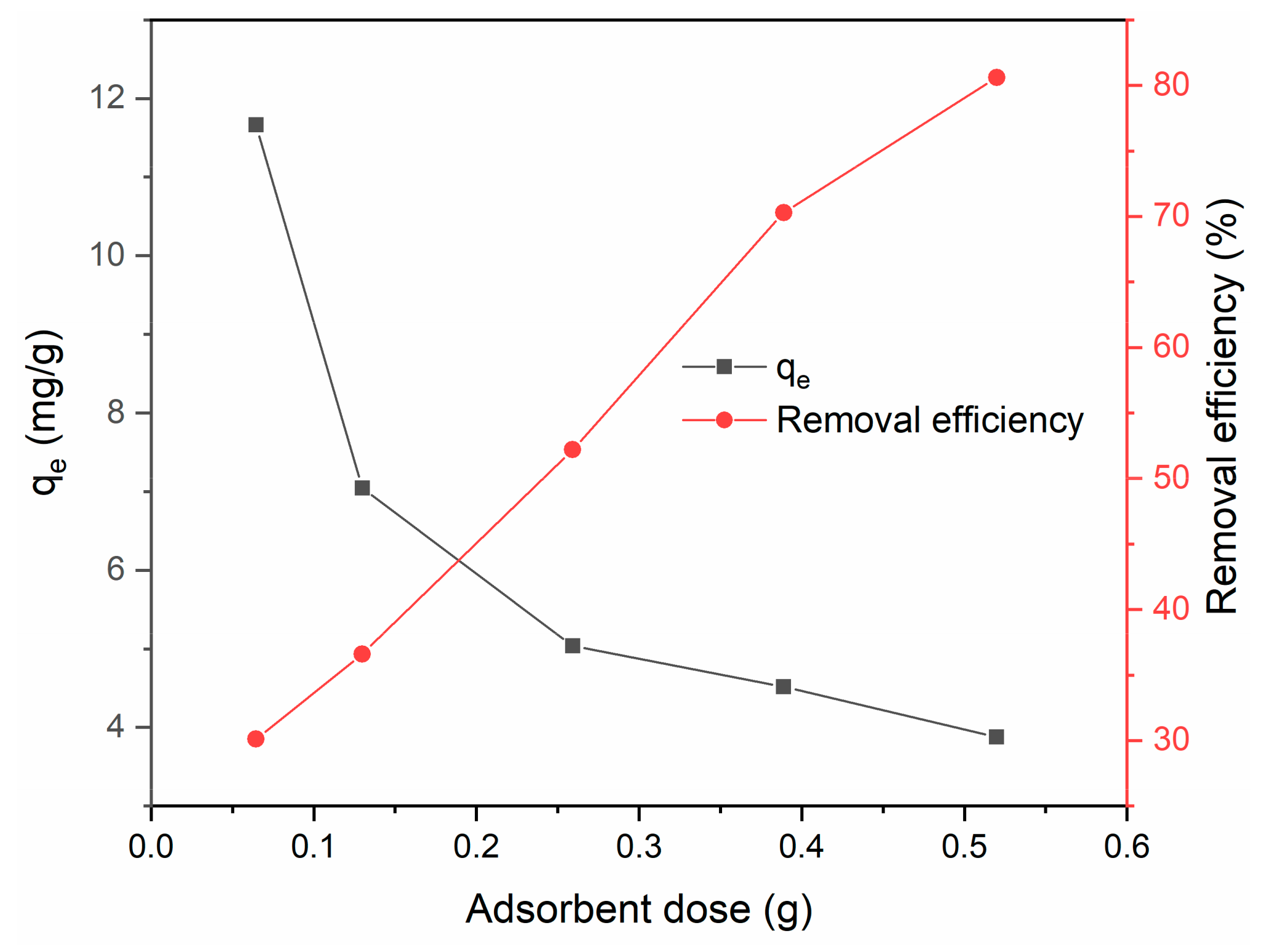

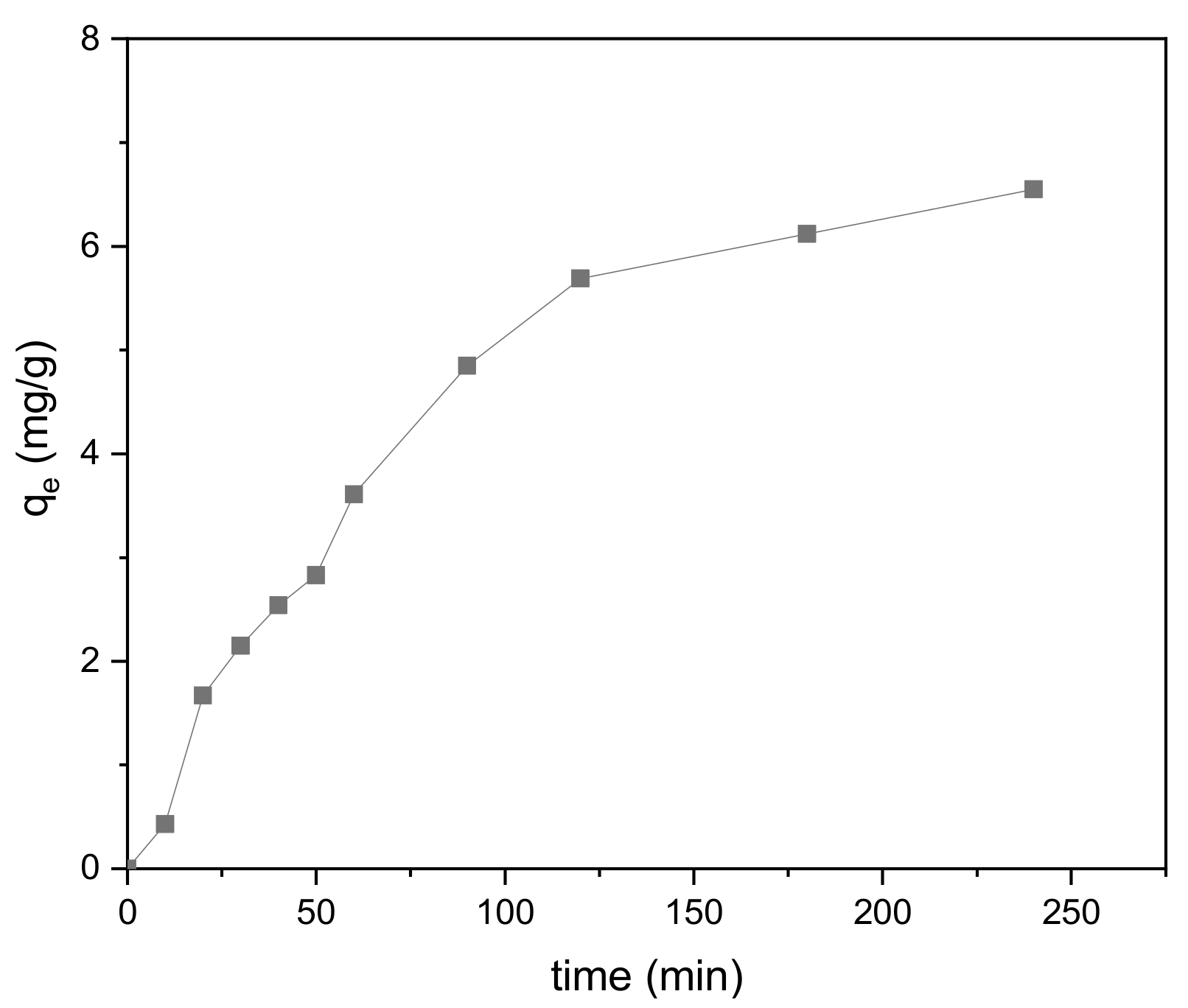

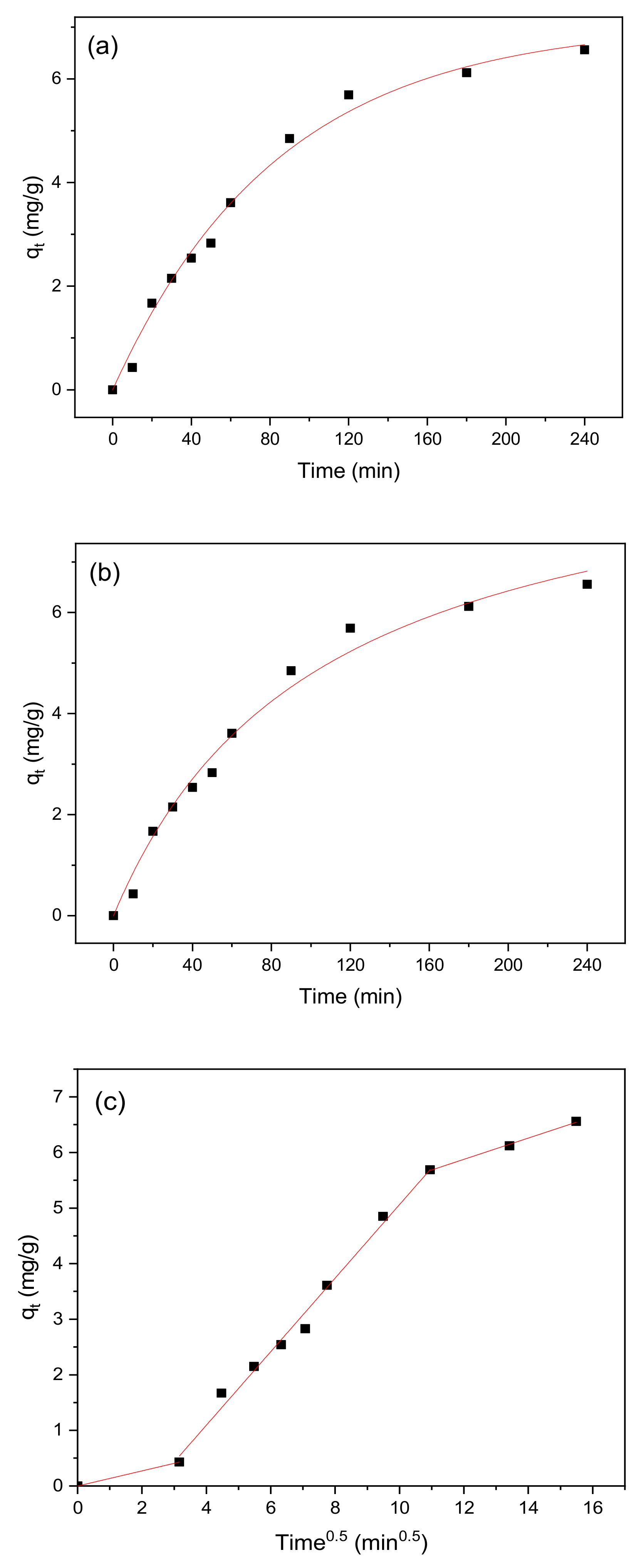
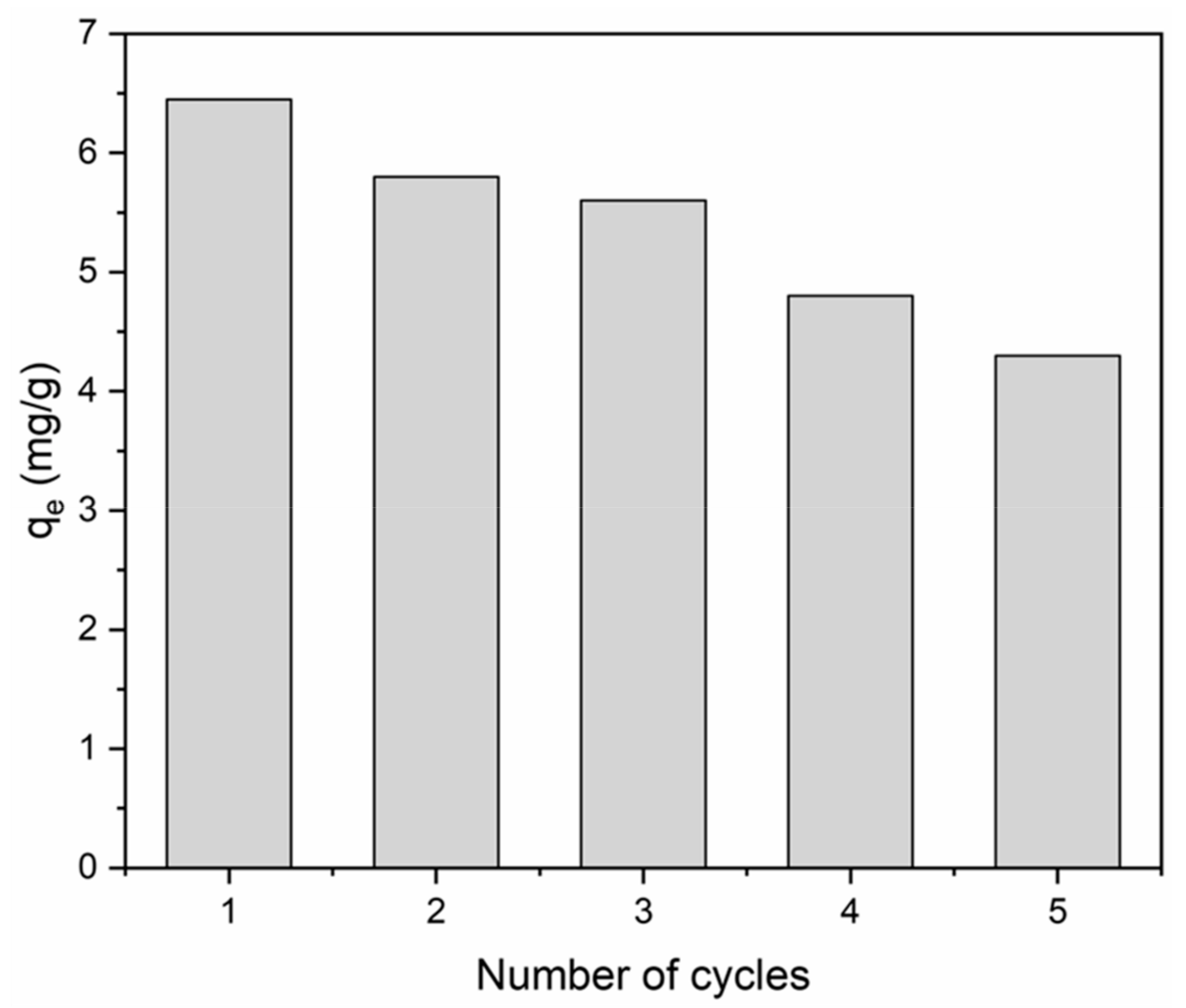
| Isothermal Model | Parameter | Temperature (°C) | ||
|---|---|---|---|---|
| 15 | 25 | 35 | ||
| Langmuir | qmax (mg·g−1) | 10.727 | 18.942 | 14.287 |
| KL (L·mg−1) | 0.036 | 0.018 | 0.070 | |
| R2 | 0.965 | 0.988 | 0.604 | |
| Freundlich | n | 2.014 | 1.567 | 2.781 |
| KF (L·mg−1) | 0.952 | 0.716 | 2.692 | |
| R2 | 0.936 | 0.988 | 0.581 | |
| Temkin | aT (L·g−1) | 0.319 | 0.250 | 0.665 |
| bT (kJ·mol−1) | 0.969 | 0.707 | 0.811 | |
| R2 | 0.975 | 0.965 | 0.601 | |
| Adsorbent | Temperature (°C) | qmax (mg·g−1) | Reference |
|---|---|---|---|
| Chitosan-crosslinked bismuth ferrite/biochar | 25 | 18.942 | This study |
| Poorly crystalline hydroxyapatite | 10 | 14.27 | [50] |
| Biochar-supported hydroxyapatite | 40 | 21.1 | [51] |
| Raw kaolin | Room temperature | 13.99 | [52] |
| Magnetic multi-wall carbon nanotubes | 25 | 15.87 | [53] |
| Acrylic acid–acrylonitrile–N-isopropylacrylamide polymeric gels | 25 | 2.79 | [54] |
| Water-insoluble β-cyclodextrin polymer crosslinked by citric acid | 30 | 13.8 | [55] |
| Parameter | Temperature (°C) | ||
|---|---|---|---|
| 15 | 25 | 35 | |
| ln K0 | −1.118 | −1.106 | −0.381 |
| ΔG0 (kJ·mol−1) | −0.783 | −0.820 | −1.748 |
| ΔH0 (kJ·mol−1) | 26.857 | ||
| ΔS0 (J·mol−1·K−1) | 82.974 | ||
| Adsorbent | Pseudo-First-Order | Pseudo-Second-Order | ||||
|---|---|---|---|---|---|---|
| BiFeO3/biochar coupled magnetic material | qe,1 (mg·g−1) | k1 (min−1) | R2 | qe,2 (mg·g−1) | k2 (g·mg−1·min−1) | R2 |
| 7.069 | 0.012 | 0.990 | 9.800 | 9.734 × 10−4 | 0.984 | |
© 2019 by the authors. Licensee MDPI, Basel, Switzerland. This article is an open access article distributed under the terms and conditions of the Creative Commons Attribution (CC BY) license (http://creativecommons.org/licenses/by/4.0/).
Share and Cite
Cai, X.; Li, J.; Liu, Y.; Hu, X.; Tan, X.; Liu, S.; Wang, H.; Gu, Y.; Luo, L. Design and Preparation of Chitosan-Crosslinked Bismuth Ferrite/Biochar Coupled Magnetic Material for Methylene Blue Removal. Int. J. Environ. Res. Public Health 2020, 17, 6. https://doi.org/10.3390/ijerph17010006
Cai X, Li J, Liu Y, Hu X, Tan X, Liu S, Wang H, Gu Y, Luo L. Design and Preparation of Chitosan-Crosslinked Bismuth Ferrite/Biochar Coupled Magnetic Material for Methylene Blue Removal. International Journal of Environmental Research and Public Health. 2020; 17(1):6. https://doi.org/10.3390/ijerph17010006
Chicago/Turabian StyleCai, Xiaoxi, Jiang Li, Yunguo Liu, Xinjiang Hu, Xiaofei Tan, Shaobo Liu, Hui Wang, Yanling Gu, and Lerong Luo. 2020. "Design and Preparation of Chitosan-Crosslinked Bismuth Ferrite/Biochar Coupled Magnetic Material for Methylene Blue Removal" International Journal of Environmental Research and Public Health 17, no. 1: 6. https://doi.org/10.3390/ijerph17010006
APA StyleCai, X., Li, J., Liu, Y., Hu, X., Tan, X., Liu, S., Wang, H., Gu, Y., & Luo, L. (2020). Design and Preparation of Chitosan-Crosslinked Bismuth Ferrite/Biochar Coupled Magnetic Material for Methylene Blue Removal. International Journal of Environmental Research and Public Health, 17(1), 6. https://doi.org/10.3390/ijerph17010006








